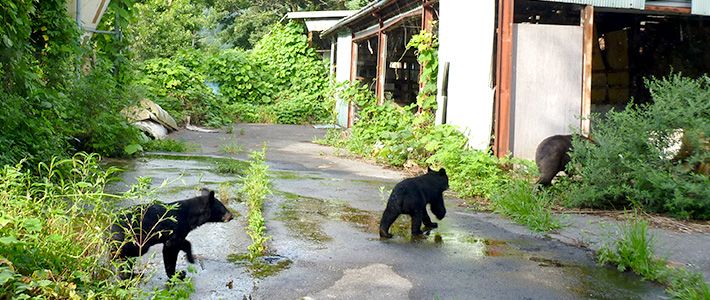
Remarkable Recovery: The Modern History of Japan’s Environment
Seeking Balance with the Bear
Society- English
- 日本語
- 简体字
- 繁體字
- Français
- Español
- العربية
- Русский
No People in the Mountains
In my excursions to Japan’s wilder places over the past several decades, I have noted a distinct human withdrawal from the satoyama, the semirural areas on the fringes of farm plots that once teemed with agriculture-related activity. There villagers tilled the land, harvested trees, gathered kindling and edible wild plants, and hunted game. The happy sounds of children could be heard as they chased rabbits, scooped fish out of streams, and caught horned beetles. In those days, wild animals kept to themselves, deep in the mountains away from the humans they feared.
Today, however, such modes of rural life are rapidly disappearing. In 2015, the Ministry of Land, Infrastructure, Transport, and Tourism and the Ministry of Internal Affairs and Communications carried out a joint survey of 1,028 municipalities including 75,662 satoyama hamlets. The ministries found that over a five-year period, 190 of these hamlets had been deserted and more than four-fifths were struggling with aging and dwindling populations or the aftermath of various natural disasters.
During the 1980s, there were increasing reports of crop damage caused by deer and bears were sighted with greater frequency. This was just around the time that the disappearance of mountain farming villages was becoming a social issue. Young people were moving to the cities; gas and electricity were rapidly replacing wood and charcoal as energy sources; and new building materials were replacing domestic lumber.
In 1980, Japan’s farming population numbered more than 6.9 million, and there were some 146,000 forestry workers in the country. By 2015, these numbers had both decreased by more than two-thirds. As a result, once-cultivated fields were taken over by kudzu and forests by tangled undergrowth, providing perfect feeding grounds for deer.
Many farming families have been giving up agriculture altogether, discouraged by their own aging, the loss of workers to non-agricultural careers, and the damage to their crops caused by wild animals. Those farmers who do continue have given up on fields that are particularly vulnerable to wildlife. Over the past decade, the number of abandoned fields has tripled opening the way to burgeoning wildlife populations that are moving ever closer to human habitats as people retreat.
The Onslaught of the Black Bears
Since 2000, there have been increasing confrontations between bears and humans, with news reports every few years of mass sightings and casualties as people are injured and killed by bears.
Up to the 1980s, the number of black bears hunted or captured and killed due to the danger they posed averaged 2,200 a year. By the 1990s, the number had dropped to around 1,500 per year, climbing again to around 2,000 as bear sightings increased. In 2006, a record 4,856 bears were captured or killed. In 2016, the number was 3,045.
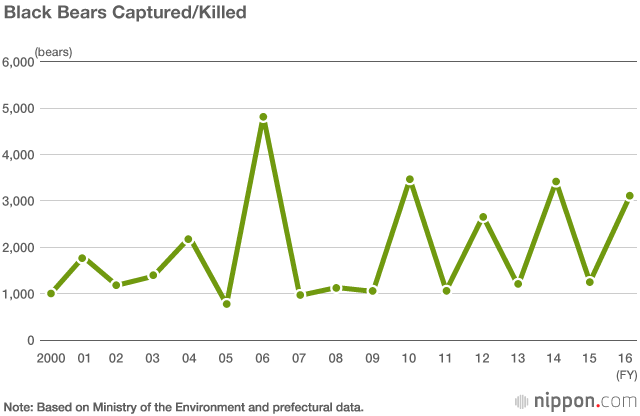
The black bear population in Japan is estimated at between 15,000 and 20,000. Designated as vulnerable species in the Red Data Book of the International Union for Conservation of Nature, the Japanese black bear is protected by the Washington Convention. Given this, it is surprising that so many bears are being captured and killed. It has been suggested that the population estimates are too low and that there are actually many more bears in Japan.
Extinct in Kyūshū
With so many kills in the population, though, will the creature go extinct in Japan? The Japanese black bear was once found throughout the nation, with the only exception being the northern island of Hokkaidō. Today, however, there appear to be no bears left In Kyūshū, where the last confirmed sighting was in 1987 when a bear was shot dead in public lands spanning the two prefectures of Ōita and Miyazaki. In Shikoku, also, there are believed to be only a few dozen bears still living.
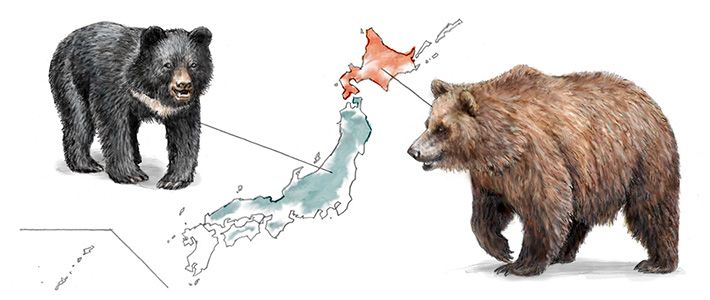 The Japanese black bear (left), today found primarily on the main island of Honshū, is characterized by the crescent-shaped patch of white fur on its chest. The adult black bear is about 1.4 meters in length and weighs between 80 to 150 kilograms. The Ussuri brown bear (Ursus arctos lasiotus; right) is found in Hokkaidō. Its fur ranges from a rusty red to black, and along with the polar bear, it is one of the largest carnivores on land, averaging 2 meters in length and weighing 150 to 300 kilograms. (Illustration by Izuka Tsuyoshi)
The Japanese black bear (left), today found primarily on the main island of Honshū, is characterized by the crescent-shaped patch of white fur on its chest. The adult black bear is about 1.4 meters in length and weighs between 80 to 150 kilograms. The Ussuri brown bear (Ursus arctos lasiotus; right) is found in Hokkaidō. Its fur ranges from a rusty red to black, and along with the polar bear, it is one of the largest carnivores on land, averaging 2 meters in length and weighing 150 to 300 kilograms. (Illustration by Izuka Tsuyoshi)
There have been large fluctuations in the numbers of bears captured or killed in recent years. Major bear infestations occurred in 2004, 2006, and 2010. Most feared is the appearance of black bears in areas inhabited by humans. In the springtime, people in rural areas commonly head into the mountains to search for edible plants to pick wild vegetables, and bear attacks resulting in injury or death are a relatively regular occurrence. In May 2016, four people were killed by bears in the mountains of Kazuno, a municipality of Akita Prefecture.
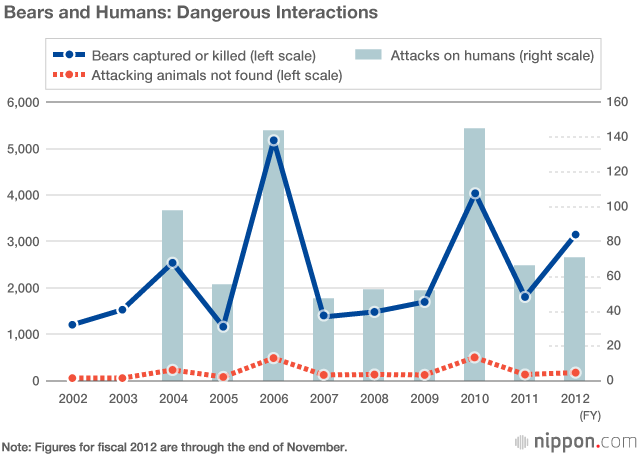
According to the Environment Ministry, 20 to 40 persons were injured or killed by black bears every year in the 1980s and 1990s. This number began to increase from 2001, and from 2008 to 2016 there were 764 casualties, including 12 deaths.
The conventional wisdom has been that bears stay up in the mountains and rarely show themselves to humans, but the animals are increasingly coming down to the satoyama rural areas, showing no fear of humans. They climb persimmon trees to eat the fruit, unconcerned as to who may be watching, and even enter houses to steal the fruit placed as offerings on family alters. Some researchers suggest we are seeing a new breed of bear that lacks the instinctive fear of humans.
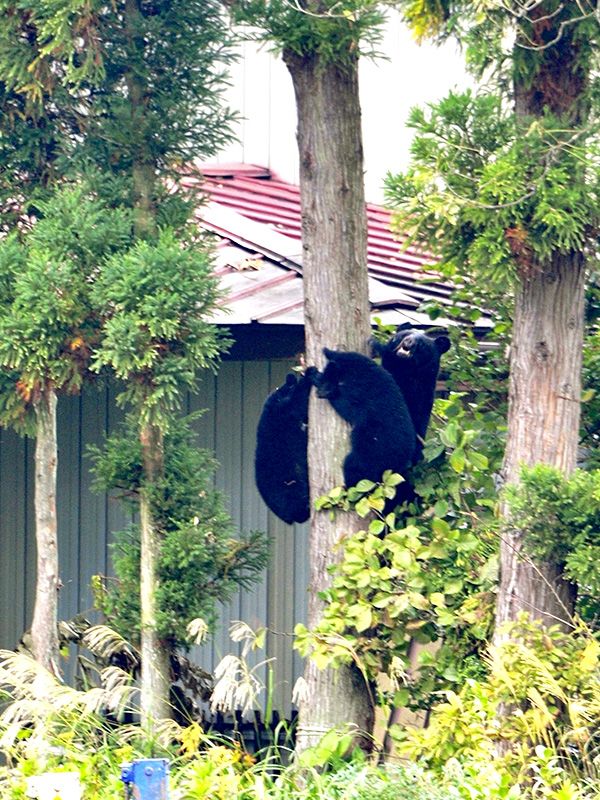 Three black bears make their way down a tree in the yard of a private residence in Iide, Yamagata Prefecture. (Photo courtesy of Yomiuri Shimbun; © Aflo)
Three black bears make their way down a tree in the yard of a private residence in Iide, Yamagata Prefecture. (Photo courtesy of Yomiuri Shimbun; © Aflo)
Bears and Acorns
Japanese black bears make their way to human habitats when there is not enough food for them in the mountains. Bears need to increase their body fat to survive hibernation in the winter. Their main source of food is the acorns of deciduous trees of the Fagaceae family, which are high in calories and rich in nutrients. The type of tree varies with the altitude. Stands of konara (Quercus serrata), kunugi (Quercus acutissima), and kuri (Castanea crenata) species of oak and chestnut are common in the lowlands where humans usually live, while buna (Fagus crenata, Japanese beech) and mizunara (Quercus mongolica, Mongolian oak) are to be found further up mountain slopes.
A study by the Forest Research and Management Organization of the Ministry of Agriculture, Forestry, and Fisheries shows that the frequency of bear sightings in areas inhabited by humans correlates directly to the abundance or lack of acorns in the mountains. Usually, if one type of tree does not produce enough acorns, another type will, but when several types of trees fail at once, the bears descend the slopes in search of food. A survey conducted by Hyōgo Prefecture’s Wildlife Management Research Center found that there were simultaneous failures of buna, mizunara, and konara acorn crops in 2006 and 2010, two years in which there were numerous sightings of bears.
Trees naturally control their acorn production as a means of survival, producing bumper crops one year and then decreasing the crop over time. If trees produced the same volume of acorns every year, the bears would eat them all and the trees would not be able to perpetuate. A poor acorn yield causes the bear population to shrink and this allows more of the acorns to germinate the next year, when there is a bumper crop.
Too Close for Comfort
In the past, however, the fluctuation in acorn crops did not push the bears to seek food in areas populated by people. Why is this happening now?
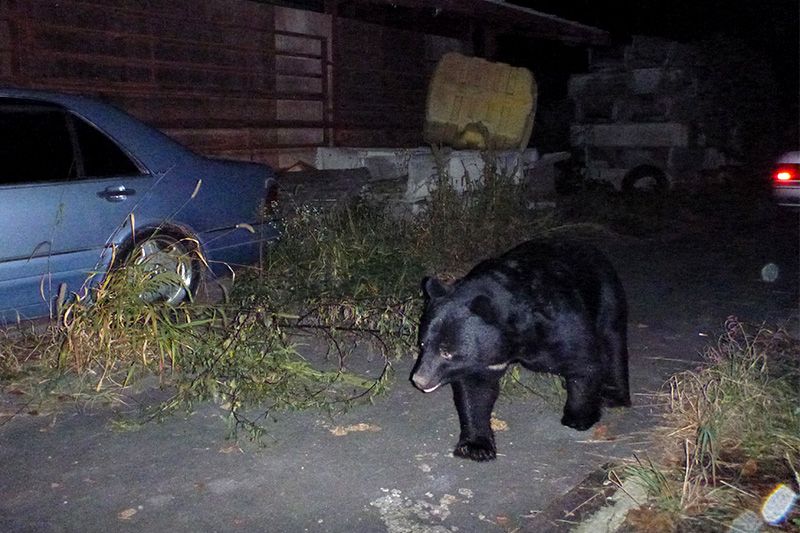 A black bear near a cow shed. It has grown fat on the cattle feed. Shiojiri, Nagano. (Photo courtesy of the Shinshū Black Bear Research Group)
A black bear near a cow shed. It has grown fat on the cattle feed. Shiojiri, Nagano. (Photo courtesy of the Shinshū Black Bear Research Group)
Japanese black bears were once found throughout the main Japanese islands of Honshū, Shikoku, and Kyūshū, but the encroachment of human populations and activities has pushed them back. A national forestry program to increase lumber production replaced slow-growing, deciduous broad-leaf forests with quick-growing evergreens like sugi (Cryptomeria japonica, Japanese cedar), hinoki (Chamaecyparis obtusa; Japanese cypress), and karamatsu (Larix kaempferi, Japanese larch). This has deprived the bears of their food and crammed them into ever-narrowing habitats.
Even as conditions changed in the mountains, they have also been shifting in the lowland satoyama areas. As village and hamlet populations dwindle, increasingly large swaths of farm and forest land are being neglected. In the past, satoyama forests were carefully managed and regularly thinned of konara and kunugi trees to be used for fuel. But as the demand for wood fuel diminished, the deciduous forests were no longer tended, resulting in a sudden increase in the number of trees—and the bear food they produce.
The decline in the satoyama human population has also made it easier for bears to encroach upon those areas. There is generally an abundance of abandoned fruit-bearing trees, such as persimmon, chestnut, and apple, and the common practice of discarding vegetables and fruits that cannot be sold in markets alongside cultivated fields provides another source of food. Fewer people and an abundance of food have created ideal conditions for hungry bears.
Reviving the Satoyama Forests
Some readers may remember the Asama Sansō hostage crisis that occurred in 1972 in the Karuizawa resort area. A standoff between members of the United Red Army and the police ended with 3 people dead and 27 seriously injured. I recently went to inspect the forest area around the site of the incident.
Images taken at the time of the incident show a denuded slope with only a scraggly secondary growth of trees in the area around the embattled summer home. There was no place for the police to hide in their onslaught. Now, more than four decades later, the neglected area is covered with growth centered on a stand of huge konara trees some 20 meters tall. In the fall, the ground is covered with acorns and chestnuts, which has brought bears to the area in recent years. Japan is seeing this kind of forest revival in many areas today.
The Japan Bear Network of researchers reports that the distribution of bears has been expanding since 2000, coming dangerously close to the sphere of human habitation in some areas. Even the large metropolitan areas of Tokyo, Kyoto, and Hyōgo Prefecture are seeing bear activity in their forested borderlands.
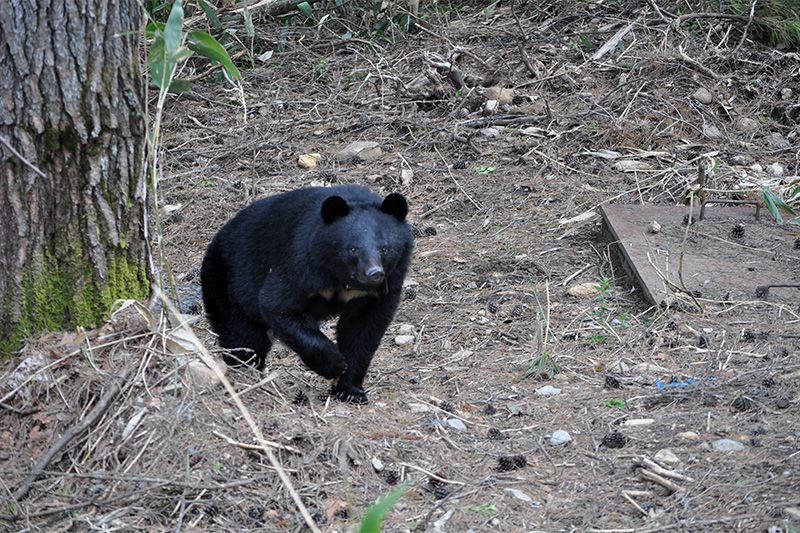 A black bear captured in the Northern Japan Alps is released after being fitted with a tracking device. (Photo courtesy of the Shinshū Black Bear Research Group)
A black bear captured in the Northern Japan Alps is released after being fitted with a tracking device. (Photo courtesy of the Shinshū Black Bear Research Group)
Bears as Victims Too
As has been noted before, much of the damage caused by wildlife stems from human action. We felled broad areas of natural forest, reforested, and then failed to maintain the reforested areas. And yet when this drives deer and bears into human habitats, we label them as dangerous pests and seek to eradicate them without a second thought.
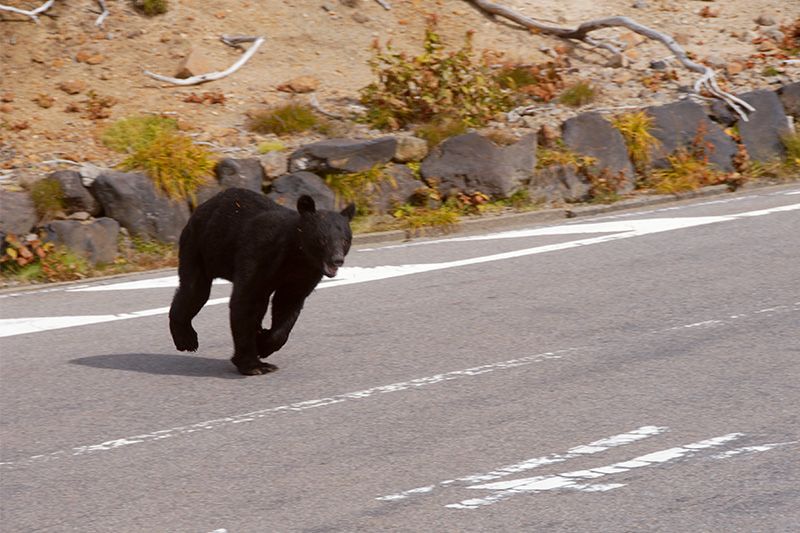 This black bear in the Norikura Plateau had already attacked a person and was immediately shot and killed after this photo was taken. (Photo courtesy of the Shinshū Black Bear Research Group)
This black bear in the Norikura Plateau had already attacked a person and was immediately shot and killed after this photo was taken. (Photo courtesy of the Shinshū Black Bear Research Group)
If current policies of exterminating wildlife are allowed to continue, we may drive them to near or complete extinction, as happened with the Ezo deer of Hokkaidō and the black bears of Kyūshū. We are so focused on the damage and danger of these animals that little effort is being put into preserving and managing them.
The issue of abandoned fields and forests is a serious one, but perhaps even more critical may be the remarkable recovery of Japan’s natural forests. Forestry as an industry is on the verge of collapse and there is a steady decline in the number of trees being cut down. The area of land covered by natural forests has remained roughly the same for the past three decades, and yet forest accumulation, a measure of the volume of tree growth, is expanding by 8,600 square meters every year. In lumber terms, this is equivalent to 4.3 million 100-square-meter houses built with conventional construction methods.
Reforestation and tree planting by NGOs and private corporations have become common activities throughout the world since the 1980s as awareness has grown of the importance of preserving forestland and the diversity of wildlife. It is not a bad thing to revive the satoyama of old or to reforest with diverse species of trees, but we must not forget that as we restore nature to what it once was, it will also demand the reinstatement of its former provenances.
(Originally published in Japanese on May 24, 2017. Banner photo: A mother and cub enter a cow shed in Shiojiri, Nagano Prefecture. There are a growing number incidents of bears attacking livestock. Courtesy Shinshū Black Bear Research Group.)